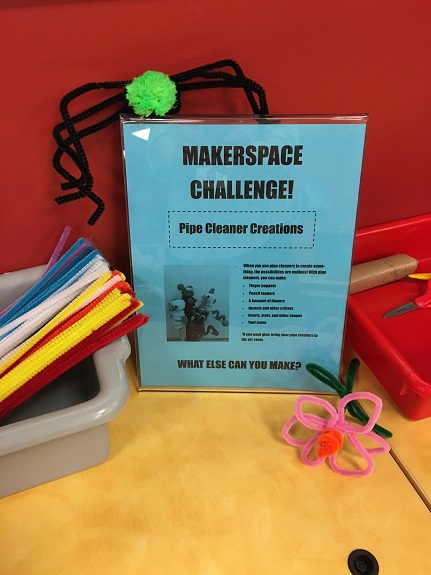Back in April of 2016, I started a kid-friendly makerspace in our computer lab. This is an unstaffed area that houses a variety of maker supplies for kids to utilize. Every month, there is a different makerspace challenge; however, kids (and teens and adults) are encourage to use the supplies available to create whatever they can imagine.
Since this makerspace has been running for well over a year now, I figured it’s time to do a makerspace update.
Makerspace Challenge is still going strong:
The makerspace challenges continue to be popular. My favorite challenge so far was a Build a Bird’s Nest challenge that I did in the spring. I had a couple of books on birds’ nests out at the makerspace, and I stocked a tray full of “nature” supplies. Ideally, I would have used actual sticks and leaves, but because materials go so quickly (and I don’t always have time to collect nature objects), I ended up using popsicle sticks for sticks, die-cut leaves for leaves, and craft feathers for feathers.
Less is more:
When I first started the makerspace, I made sure that it was as full of a wide variety of supplies as possible. However, since this area is unstaffed, I quickly learned that it’s best not to have too much stuff out. The more supplies you have, the bigger the messes will be:
Special or seasonal supplies are fun:
There are certain supplies that are always out. Tape, scissors, pipe cleaners, and popsicle sticks are the norm for the makerspace. But every now and then, I like to change things up by adding something new and fun. For a few days during the summer, I had sea shells in one of the drawers. One weekend, I brought out the big, sturdy cardboard tubes. Kids went nuts one day when I added some mylar sheets. It’s always fun to see what kids will build with these different supplies.
Dreaming BIG:
I’ve been spending some time thinking about how I want the makerspace to grow, and the dream is for it to someday be a staffed area where we can utilize other supplies, such as little bits and 3D printers. Due to staffing levels, I think that will remain a dream for a little while, but there are some exciting changes that will hopefully happen. For example, my department FINALLY got its own 3D printer (I have been trying to get one for our department for YEARS now). I already offer 3D printing classes, but now that I actually have a printer for the department, I’m hoping to utilize it by printing some maker supplies (maybe some gears?) for the makerspace, and maybe offering different types of 3D printing programs. SO EXCITING!!!




























